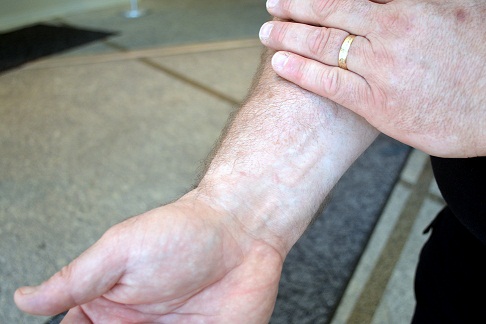Heart care through your wrists?

If you asked Mark Hobson to compare the two cardiac catheterizations that he’s had, he wouldn’t hesitate to say which he preferred. Hobson sought treatment for chest pains.
“The second one was so much better…by a long-shot,” says Hobson, a 53-year-old public safety officer at Advocate Condell Medical Center in Libertyville, Ill, who has a history of heart disease.
What was the difference? The first procedure was done through his femoral artery—the method that is used in the vast majority of heart catheterizations in the U.S.
“For the second heart cath, they went in through the artery in my wrist,” says Hobson, showing a tiny scar about the size of a pea. “Was much easier, way more comfortable and I was up and back at work faster. I left with a small bandage on my wrist, and that was it. I couldn’t believe the difference.”
According to the American Heart Association (AHA), cardiac catheterizations remain one of the most common invasive procedures performed in this country, with an estimated 2.7 million Americans undergoing the procedure each year.
In the U.S., 95 percent of cardiac catheterizations are done through the femoral artery, while less than 4 percent are performed via the artery in the wrist, according to the AHA.
During a cardiac catheterization, small tubes are inserted into the circulatory system either through the femoral or radial (wrist) arteries to get information about blood flow and pressures within the heart. It can also determine if there are obstructions within the coronary arteries that feed the heart muscle. Many times, cardiologists performing the procedure will insert stents to open up an artery and help restore blood flow.
Dr. Timothy Alikakos, an interventional cardiologist at Condell Medical Center who performed the procedure on Hobson, says, “When you go in through the femoral artery in the groin, there is greater risk of bleeding, and the patient needs to remain prone much longer after the procedure. When you go in through the artery in the wrist, there’s virtually no bleeding risk, the patient can walk around after the sedative for the procedure has worn off and it is much more comfortable for the patient.”
Dr. Alikakos says that since there are so many advantages of a radial catheterization over the traditional method, people may wonder why more cardiologists aren’t performing them.
“In Europe most catheterizations are performed through the radial artery,” says Dr. Alikakos. “We are much slower on uptake for a number of reasons. Many cardiologists aren’t trained to go through the radial artery. And, the procedure is more technically challenging—the radial artery is smaller than the femoral artery, and for many years the equipment to fit that artery hasn’t been available here.”
Radial catheterization isn’t appropriate for all patients, however, he says. “If the patient has a complex condition that would require using a larger catheter, then the femoral artery approach is more appropriate,” says Dr. Alikakos. “Patients must also have good blood supply to the wrists via both the radial and ulnar arteries.”
Hobson is thankful that he had his procedure done this way. “Psychologically, the difference was huge prior to the procedure. Lying on the table with my arm out versus going through the femoral artery made me feel, mentally, more comfortable with the procedure, as well.”
Related Posts
Comments
2 Comments
About the Author
health enews staff is a group of experienced writers from our Advocate Health Care and Aurora Health Care sites, which also includes freelance or intern writers.



















My mother had a heart cath through the radial artery last year, and her recovery was much quicker and easier than going through the traditional femoral site. I wondered too why more caths weren’t performed with the newer procedure and why the public wasn’t more aware of it. Thanks for answering that, Josh.
Chris to answer your question , $$$$, that’s why!